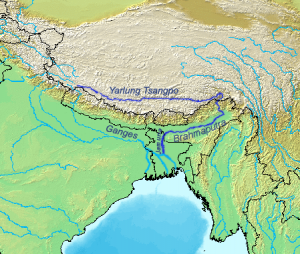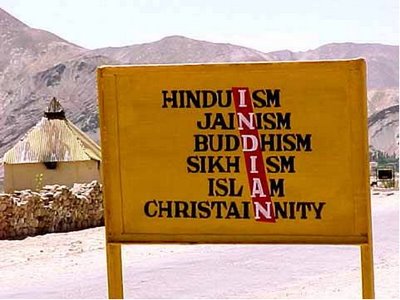What does Tibet as a region/country/people mean to us, as Indians? and in this context, how do concerns about China play out via Tibet, and now via Nepal?
Handling of Tibet
Tibet, upon (only initial) examination represents one, and only one of the many feathers that crown our government’s
foreign-policy failures. This statement is not as much to criticize, but at least for us to recognize that India’s handling of Tibet, and management of relations with China have been a disaster – marked by myopia, weakness, lack of resolve and steadfastness – and overall a ‘theekh hai, chalega, koi baat nahi’-attitude.
[the attitude expressed in different languages & not to be hindi-specific]
The Brahmaputra starts in Tibet
Tibet is a back-door to India. India in its negligence of Tibet seems to have forgotten that ‘Tibet’ is where the great Brahmaputra starts. The intelligentsia (RAW etc) no doubt have access to solid information, but none of this is reflected in how the government has behaved with China. So, what about this river? We are now a few years away from the execution phase of China’s diversion of the Brahmaputra into northern China. How about that? This is the river that supplies 40% of India’s fresh-water supply.
China & India share the Brahmaputra, originating in Mount Kailash – in Tibet. By annexing Tibet, China owns its natural resources. Using a generic description from wiki – [quote]”From its origin in southwestern Tibet as the Yarlung Tsangpo River, it flows across southern Tibet to break through the Himalayas in great gorges and into Arunachal Pradesh where it is known as Dihang. It flows southwest through the Assam Valley as Brahmaputra and south through Bangladesh as the Jamuna. There it merges with the Ganga to form a vast delta.”[/quote]
The wiki page shows a map of the river flow through Tibet and then to India. It is true that China has immense water  problems in its North – where 300+ million people live. The point to note is that China will not bat an eyelid before just ‘doing’ what it thinks right to solve its impending water crisis. The incredible U-shaped bend of the Tsangpo-Brahmaputra into India is where the action will be.
problems in its North – where 300+ million people live. The point to note is that China will not bat an eyelid before just ‘doing’ what it thinks right to solve its impending water crisis. The incredible U-shaped bend of the Tsangpo-Brahmaputra into India is where the action will be.
Here’s what James Johnston (writer, river-runner & white-water rafting guide) comments –
[quote]”The geography of South Asia is such that every manipulation of a river by the Chinese has a trickle-down effect. Tibet is known as ‘the roof of the world’. It’s the watershed area for ten of the world’s greatest rivers that flow through deep canyons into Asia like giant gutters after heavy rain; feeding almost half of our entire planet’s population. Tampering with these vital waterways in an age of growing climate-change awareness seems ludicrous, yet this is exactly what the Chinese are proposing. Picture the Himalayan glaciers as a massive natural water tank for the world. China wishes to punch a great big hole in that tank and steal water away from its neighbours through a buried pipe no one seems to have noticed.”
… his full article “We All Live Downstream” (July 15, 2007) [Hong Kong newspaper][/quote]
China is attempting a massive engineering feat, and is perhaps even capable of it. Apart from the concerns of highly inappropriate methods of water-deviation, the U-shaped bend happens to be located in an earthquake-prone zone. Badgering a 15km hole through Himalayan rock to facilitate this diversion of water away from North-India might ‘work’, but who is to claim responsibility if these gargantuan plans backfire? The ‘badgering’ will not use conventional weapons and detonating material – that according to Chinese studies (which have been on for years) will not be enough. They will – yes, you guessed it ! – be using loving Nuclear weapons for destruction of this Himalayan rock. This also has consequences.
People of more than one nationality have their livelihood at stake – but isn’t that all the more reason that these plans be at least discussed? Another off-shoot (literally) of Chinese water-manipulation at this scale is that what flows in Tibetan waters is going to impact us – adversely. Tibet, apart from its long list of other abuses – has also been made into a huge nuclear waste disposal ground.
China claims the sites in Tibet are now converted to “factories” but no Tibetans or foreigners are allowed to visit the areas. Disease & death in these regions of nuclear waste are common (of course) – though if we were to get *our* interest level up – it should stem from the fact that Tibetan water will carry what’s in the ground. It is only a matter of time before this radioactive waste makes it to Indian soil & hurts people of Indian origin (since for the most part, Tibetans are “those” people and look different). Perhaps then it will matter to us..
It is not surprising in any way that the competition for natural resources would be such a huge aspect of the kind of competition that countries and economies play with each other. But at the very least, we should start hoping, and expecting that *people’s* needs of these resources (irrespective of nationality) are solved via rational means, in a manner agreeable to parties concerned.
The end result of the Brahmaputra diversion is that China will hold the on-off switch – to decide when to open the gates of the river to India and when not. Given the scarcity of water in northern China, and if forced to guess – they would not have good reason to open the gate anytime.
What China expects from us
This has proved to be very costly. China expects nothing short of the our government sucking up to them and being yes-men, essentially. India has on more than one occasion bent to any form of pressure from China and accepted its machinations as is. Hope is not lost, though – India is still in a position to show strength at this crucial, defining moment in Asiatic history. If anything, there is non-zero momentum with the Olympics around the corner. [More below on what India can do]
Their regime is good for us?
China is a devious, calculating, imperialist empire that is incapable of admitting a mistake, and capable of extreme aggression. To keep our focus – this isn’t about the poor Chinese grandmother who sits along with her grandchildren breaking down electronic equipment (dumped from the US or other developed nations) hour after hour, day after day to earn one square meal a day. This is about Chinese decision makers – the one-party government that takes its inspiration from an adapted form of Maosim, Communism & regimented Capitalism.
The First Error
There was a sorry time in the late 50s that I learnt of, when the propaganda in India was ‘Chini-chini-bhai-bhai’ – a time when India was pursuing a weak, misinformed policy of encouraging “brotherhood” with China – this is when Mao had sullied China with the strains of Communism and made claim to represent ‘the Chinese people’. This, despite a myriad rebellions that were brutally crushed in the ‘interests of the state’.
Recognizing Red China was thus first of many grave errors.
We had at the time – the extra-ordinary option of refusing to give legitimacy to a regime backed by this murderous ideology that would hurt all involved. The West’s obsession with GDP, and ‘free-trade’ have long prostituted the rights of the individual- rights self-evident in free societies, but blasphemous when ‘the State’ towers above the individual (as it is in Communist regimes)
And the first demonstration of China’s intentions
Rajeev Srinivasan has an excellent write up giving a concise background on what exactly happened back then in India – his article appeared in Rediff recently, titled simply : The sacrifice of Tibet: Extraordinary delusions and temporary insanity (Mar 25, 2008)
While Nehru proposed the spineless & inactionable Panscheel agreement, the Chinese behind the scenes prepared for a full-fledged attack on Indian soil (India lost the war, and ceded north-east Ladakh to China, now Aksai-Chin). [1]
Wiki lists the region now as “administered by China, and claimed by India”. This goes beyond Aksai-Chin, and beyond the naivety of our statesmen.
On the Significance of Mao’s Tibet adventure
K.D.Sethna in 1950 – a whole 12 years before China unleashed their military on India wrote :
[quote]”The basic significance of Mao’s Tibetan adventure is to advance China’s frontiers right down to India and stand poised there to strike at the right moment and with right strategy, unless India precipitately declares herself on the side of the Communist block. But to go over to Mao and Stalin in order to arrest their wrath is not in any sense a saving gesture. It is a gesture spelling the utmost ruin to all our ideals and aspirations. The gesture that can serve is to take a firm line with China, denounce openly her nefarious intentions, and stand without reservation by the USA and make every possible arrangement consonant with our selfrespect to facilitate an American intervention in our favor and, what is of still greater moment, an American prevention of Mao’s evil design on India. Militarily, China is almost ten times as strong as we are, but India as the spearhead to an American defense of democracy can easily halt Mao’s mechanized millions. And the hour is upon us of constituting ourselves such a spearhead and saving not only our own dear country but also South East Asia whose bulwark we are. We must burn it into our minds that the primary motive of Mao’s attack on Tibet is to threaten India as soon as possible.”[/quote]
Geographical claims – N.E Kashmir, Arunachal & now Sikkim
To date, China does not even recognize Sikkim as a part of India, does not recognize Arunachal Pradesh [2] (it has made full claims to the states, barely, if at all, even coming to the discussion table – suggesting on more than one occasion that these are non-issues, and beyond ‘discussion’)
Where would China ‘stop’ ?
There is no reason for this aggression to come as a surprise. As far back as 1951, Sethna wrote in the then-politically-charged monthly Mother India :
[quote]”With Tibet incorporated in China, we shall have Mao touching Kashmir, Uttar Pradesh, Nepal, Sikkim, Bhutan and Assam. Our physical frontier with China will lengthen by hundreds of miles. Ideological infiltration will increase enormously.” [3][/quote]
China is not blood-thirsty, but unlike India, they don’t mind war, military aggression & violence, as long as they achieve their goals. Mao, his cronies and the PLA have on more than one occasion affirmed their belief in this regard.
Apart from their expansionist tendencies, China is also gripped with spreading its ideology, which they see as ‘liberating’ the people of other countries.
It is not clear how they plan to effectuate this.
But they have a rolling start – first Tibet, then Nepal (now ceded completely to the Maoists), and the result is we have a massive stretch of India’s north-east borders debilitated. Maoists now operate freely in Chattisgarh, Madhya Pradesh, Orissa, Bihar, Jharkhand, Karnataka, Maharashtra and north Andhra Pradesh.[4] The ideology and the problems associated with it aren’t past-tense. Millions swear by Mao even today.
Two thoughts that come to mind :
1. Tibet, if nothing else & ignoring all the humanitarian concerns – is of grave importance to our National security & Strategic interests.
2. Our relations with China need to be recast with a new identity of strength & resolve – not for any political theatrics, but to actually protect the state.
This is fine, but what can India really do?
There are many ways to go about this, but to date the most practical way out I have seen come from the strategic choices offered by Rajiv Malhotra in one of his talks.[5]
- Make India play Tibet as China plays Arunachal & revoke restrictions on HH from political activity on Indian soil.
- Swiftly establish successor-ship to his HH the Dalai Lama
- Lobby the US to get its act together.
This is, of course – but one solution.
[dhr]
References / Notes
[1] The communists in India of course, like to believe India launched the war against China.
[2] Arun Shourie had an interesting title to a recent article of his – it read “Shilpa Shetty trumps Arunachal Pradesh again” (terrific piece about what’s happening in Arunachal) Urban India chose to consume dialogues of the famed TV show in UK, and less than a passing mention of the bleeding of India’s borders, and even lesser of the multilple failures of dialogue with China on this issue. As Bill Gross wrote not so long ago (about America) “we for long have chosen to be entertained rather than informed”.
[3] K.D.Sethna, pg 198 ‘India and the World Scene‘. ISBN 81-7060-118-5
[4] P.Paul, “The Naxal Corridor”, http://www.bharat-rakshak.com/SRR/Volume21/paul.html
[5] he’d discussed these briefly at a meeting on Tibet’s Quest for Freedom organized by the Friends of India Society in May 2008.
Notes- I, II
part I – Claude Arpi, a gentleman of French origin, and a long-time resident of India, and has studied the Tibet-China-India maze at great length, he had this article published in October of 2003 – “Diverting the Brahmaputra: Declaration of War?” that gives a more vivid (and full description, in case it interests you) of the turn of events, despite being 5 years into the past.
part II – Taking from Patrick Hughe’s research titled – Environmental Degradation in the Tibetan Autonomous Region, one observation that struck me from here was that Tibet’s forests have been nearly halved – for timber, principally; 221,800sq.km in 1949 to 134,000 sq.km as of 1985. Official records for the last 25 years are hard to obtain (as expected)



